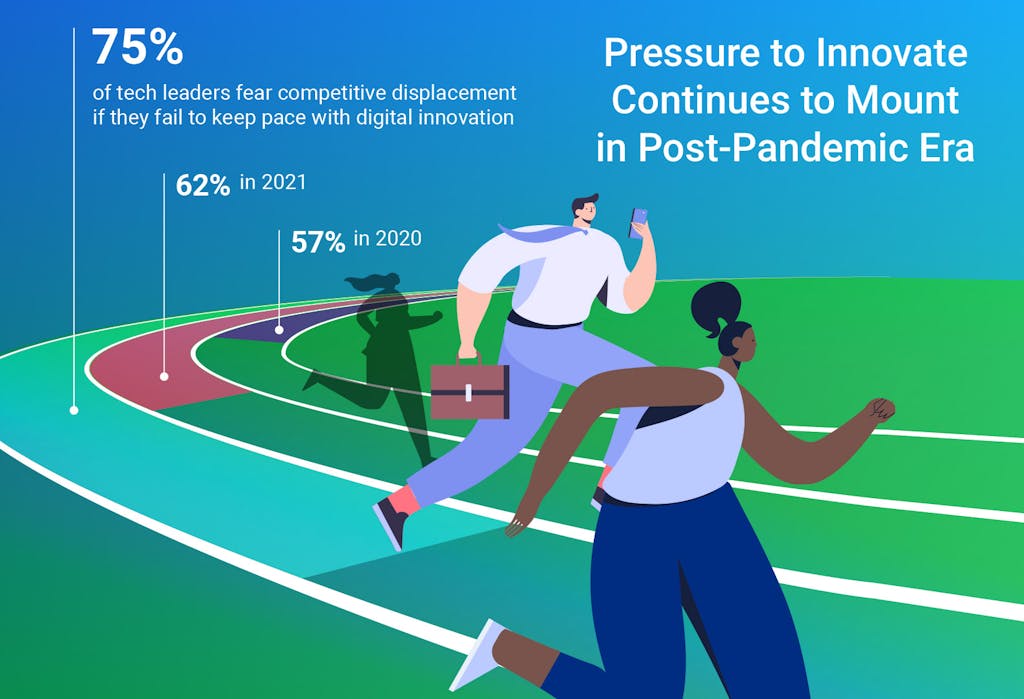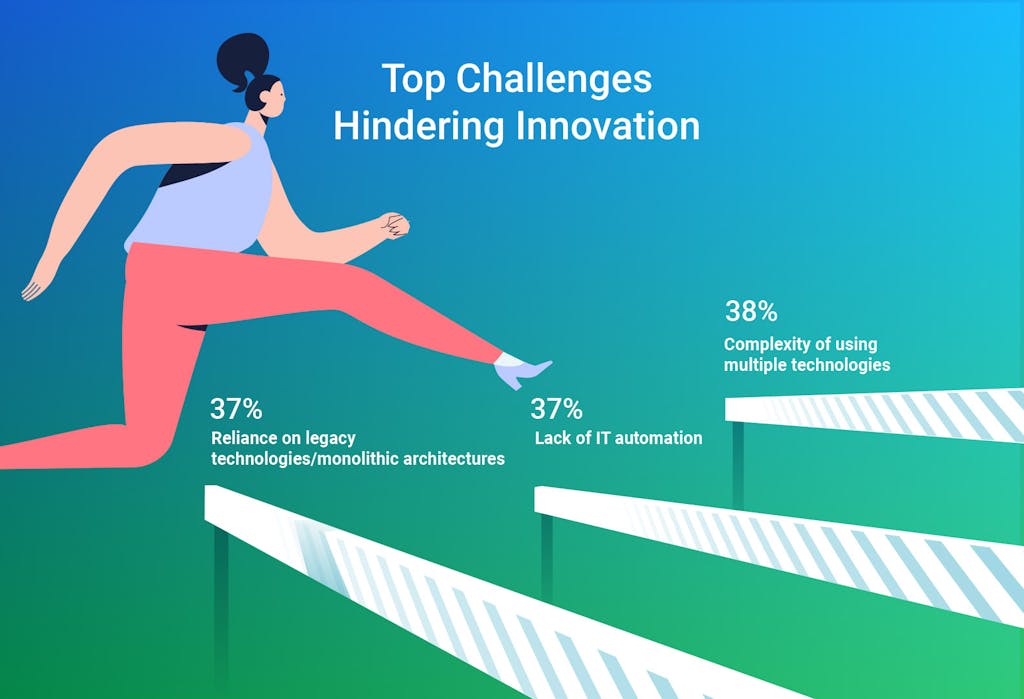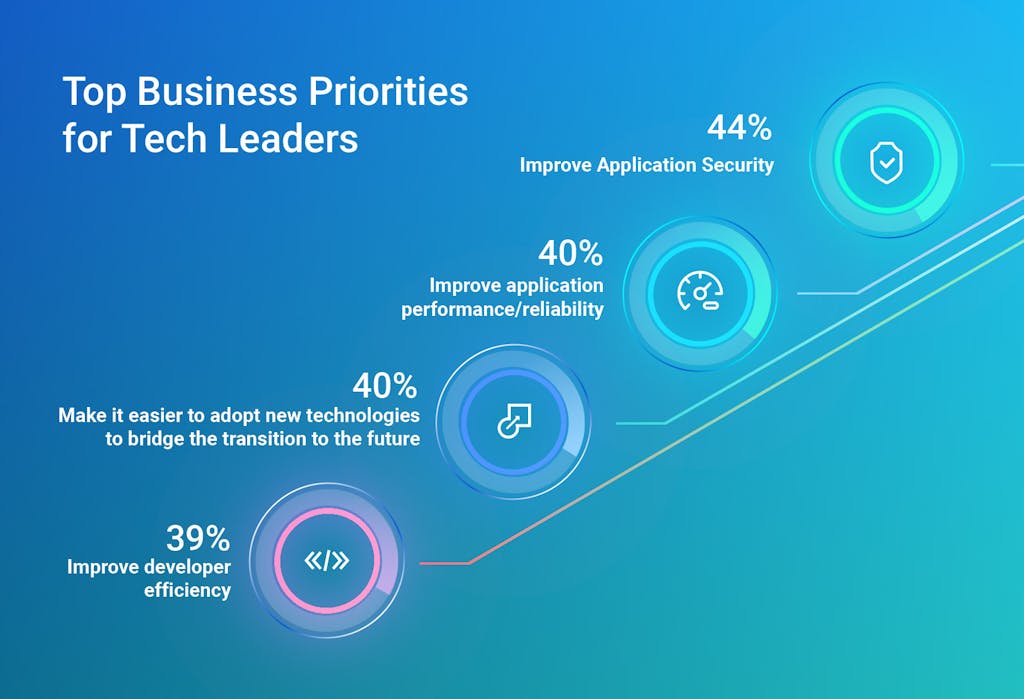This is Part 1 of a three-part blog series that will dive into industry insights from technology leaders who are facing the next wave of digital innovation head-on.
Today, we meet again at the cusp of the next frontier. This time, it's Web3, the metaverse and boundless connectivity. Businesses everywhere are bracing for what's next while preparing for the onslaught of new-wave digital experiences. These experiences will move at hyper-speed, where consumers will expect instantaneous delivery, from getting flight alerts on your smartwatch to ordering a pizza with the tap of a finger. Businesses that drive innovation will emerge as king of the jungle, while others will face displacement.
According to our new 2022 API & Microservices Connectivity Report, 75% of technology leaders fear competitive displacement if they fail to keep pace with digital innovation, up from 62% in 2021 and 57% in 2020. In fact, 4 out of 5 predict they will go under or be absorbed by a competitor within six years if digital innovation lags, while 2 out of 5 predict an even shorter survival window of three years or less. So how does one stay ahead of the troop? It turns out the secret was in plain sight - right there in your developer team.

IT and App Modernization
Tiny Teams and Old Tech: A Modern Conundrum
Capturing the full potential for digital innovation relies heavily on seamless connectivity between applications. APIs are the backbone to this connectivity, fulfilling requests (like that pizza you ordered) in real time. Developers rely on APIs to build applications, and businesses are looking to empower developers with the tools to create unparalleled customer experiences. Bad stuff in will mean bad stuff out, and legacy architectures have long been a hurdle for developers to realize digital transformation for businesses.
Complexity of using multiple technologies (38%), reliance on legacy technologies/monolithic architectures (37%) and lack of IT automation (37%) were cited as top challenges hindering innovation. On top of this, the Great Resignation has shrunk developer teams, straining resources and productivity. According to the report, 34% of respondents cited lack of skills and talent as a drag on innovation. At this point, improving the developer experience is non-negotiable in order to enable development of futuristic applications, innovate at scale and deliver a world-class digital experience for your end user. At the end of the day, happy developers equal happy customers.

Modern Technology Adoption
Turning the Tide in Your Favor
Investing in modern tools, enabling developer efficiency and removing tech complexities are key to improving the developer experience. To create this unbeatable developer experience, technology leaders have streamlined a few priorities:
- Improve application security (44%)
- Improve application performance/reliability (40%)
- Make it easier to adopt new technologies to bridge the transition to the future (40%)
- Improve developer efficiency (39%)

By doing away with roadblocks stemming from old technology and picking solutions with built-in security and unparalleled performance, businesses enable their developers to regain critical time to focus on actually building those game-changing applications. To determine ROI on innovation, technology leaders have set some metrics for what success looks like. Here are a few things to prioritize when charting your innovation roadmap based on survey respondent data:
- Service reliability and availability (94%)
- Application performance and scalability (93%)
- Risk mitigation (e.g. security, compliance, data privacy) (93%)
Of course, there is no quick-fix; keeping pace means continuous innovation. The data shows that most businesses have found that investing in modern technology has empowered their developers to deliver on the business commitments to customers. To read more about the findings from our latest 2022 API & Microservices Connectivity Report, you can:
- Download the full report
- Check out our infographic
- Join the "Building a Winning Digital Experience Strategy Starts With Empowering Today’s Developers" webinar on April 14
Stay tuned for Parts 2 and 3 in this blog series, where we'll dive deeper into the trends driving these changes and look at how businesses today are enabling their developer teams to drive innovation.





